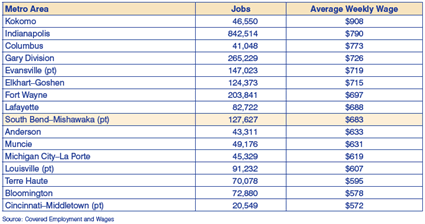The South Bend-Mishawaka Metro Area
The South Bend–Mishawaka, IN-MI Metropolitan Statistical Area (metro) consists of St. Joseph County in north central Indiana and neighboring Cass County in Michigan. The metro has a total population of 318,192, with about 84 percent of those residents living in Indiana. This article will focus on those 266,431 Hoosiers.
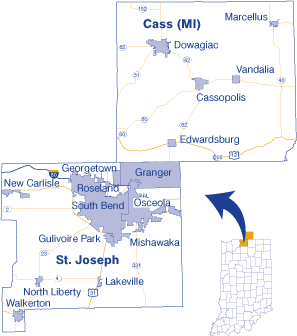
St. Joseph is the fourth largest county in the state (after Marion, Lake and Allen County, respectively). Between 2000 and 2004, the county added almost 600 residents, growing a rather slow 0.2 percent. Nearly 40 percent of the county lives within South Bend’s city limits, while another 18 percent are found in Mishawaka.
According to population projections from the Indiana Business Research Center, the Indiana portion of the metro will add about 17,454 residents by 2020, growing 6.6 percent from its 2004 population. This is 1.6 percentage points slower than the state. South Bend–Mishawaka will see the largest increase in the group age 45 to 64, while young adults age 25 to 44 will be the only age group to decrease.
Industrial Mix and Jobs
Manufacturing holds the largest employment share in St. Joseph County with 18,580 jobs, as of the fourth quarter of 2004. At 14.6 percent, the county is more diversified than the state overall, which has nearly 20 percent of total employment in manufacturing (see Figure 1).
Figure 1: Percent of Total Employment by Industry for St. Joseph County and Indiana, 2004:4
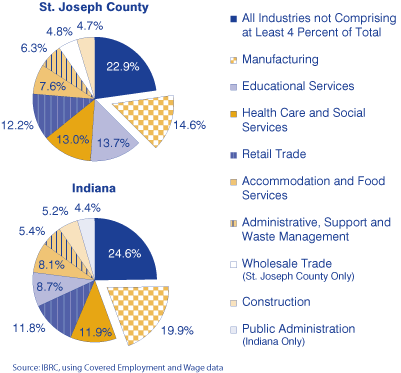
As seen in Table 1, AM General, producer of Humvees for
the military and the Hummer H2 recreational vehicle, is among the largest
employers in the region. The company employs about 2,300 Hoosiers and
has seen its Humvee production jump from less than 1,000 vehicles in 2003
to an estimated 5,400 for 2005, undoubtedly due to the ongoing conflicts
in Afghanistan and Iraq. (1) The other manufacturer on the list,
Honeywell Aircraft Landing Systems, employs about 1,400 people and supplies
aircraft wheels, brakes and other components of landing systems.
Table 1: Major South Bend Metro Employers
Manufacturing employment has been relatively stable in the county during the past several years, with a job loss of just 0.5 percent between the fourth quarters of 2001 and 2004, compared to Indiana’s 3.7 percent slide. Overall, the South Bend–Mishawaka job market expanded 2.2 percent during this time frame, adding 2,731 jobs and bringing the total to 127,627.
The fastest growing sector was administrative, support and waste management services, adding over 3,300 jobs and growing more than 70 percent since the last quarter of 2001. The biggest losses were in retail trade on a numeric basis (-1,321) and in construction on a percent basis (-16.6 percent).
Using Local Employment Dynamics data to observe job creation trends, we find an average of 6,535 new jobs per quarter between 2001:1 and 2004:1. As seen in Figure 2, the number of new jobs created during the latest quarter available (2004:1) totaled 5,489 and represented 4.3 percent of total employment.
Figure 2: St. Joseph County Job Creation, 2001 to 2004
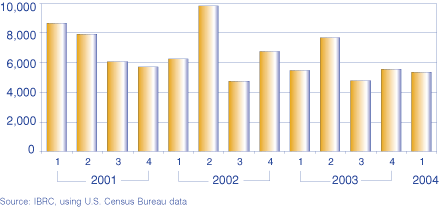
Commuting
The number of people living and working in St. Joseph County exceeds 144,000, while 18,735 people from other counties find work in the Indiana portion of the metro. About 17,000 St. Joseph County residents commute out of the county for work—with the majority going into neighboring Elkhart County (see Figure 3).
Figure 3: St. Joseph County Commuting, 2003
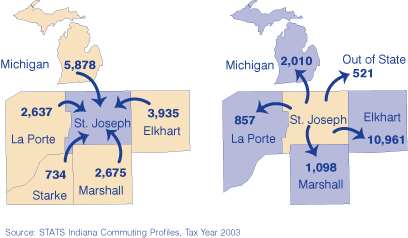
According to the 2004 American Community Survey (ACS), the average travel
time to work for those in St. Joseph County was just under 20 minutes.
Less than 7 percent of workers 16 and older carpooled to work, and a mere
1.2 percent took public transportation. Not surprisingly, 87.8 percent
traveled alone.
And just what vehicles are residents driving to their jobs? Registration data from the Bureau of Motor Vehicles indicate that 15.7 percent of the 140,706 registered vehicles in the metro are Chevrolets, followed by Fords at 13.9 percent and Toyotas at 7 percent.
Wages and Income
According to the ACS, median household income for 2004 is estimated at $37,971 in St. Joseph County, a few thousand less than the state’s $42,195. Looking at both ends of the spectrum, 8,205 households (8 percent) earned $100,000 or more, while 12,300 households (12 percent) earned less than $15,000.
Ten percent of people in the South Bend–Mishawaka metro were in poverty in 2004. That includes 12.2 percent of children under 18, 3.5 percent of senior citizens, 7.1 percent of all families and 21.2 percent of families headed by a single mother. These numbers are in line with the distribution at the state level. However, South Bend–Mishawaka has a significantly lower percentage of its senior citizens in poverty than Indiana as a whole (3.5 percent as opposed to 7.3 percent)
The industry detail for 2004:4 from the Covered Employment and Wages data showed average weekly wage at $683, ranging from $227 in accommodation and food services to $1,620 in management of companies and enterprises. While the average wage for all industries combined fell $23 short of the state average, eight industries had wages higher than Indiana. These were led by management of companies, which had an average weekly wage $379 above the state.
Between the fourth quarters of 2001 and 2004, 12 St. Joseph County industry
sectors saw wages grow more than 10 percent, and most of those surpassed
the state’s growth (see Table 2). Three industries experienced a
decline in average weekly wages, with the largest being an 11 percent
($41) drop in administrative, support and waste management services—most
likely the result of the intensive hiring in that sector.
Table 3 shows that South Bend falls in the middle of the pack relative
to other Hoosier metros with respect to wages for total covered employment,
ranking ninth out of the 16 areas.
Table 3: Average Weekly Wages in Indiana Metros, 2004:4
Notes
- Norm Heikens, “Humvee builder is at a crossroads,” Indianapolis Star 25 August 2005.
Rachel Justis, Managing Editor
Indiana Business Research Center, Kelley School of Business, Indiana
University


